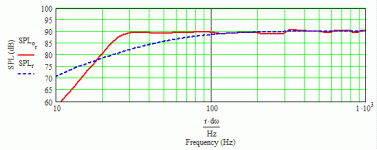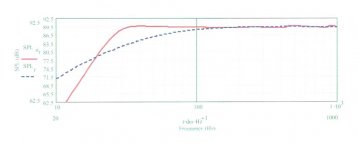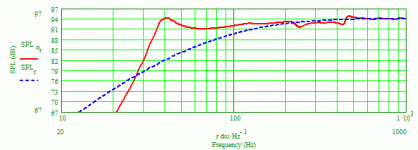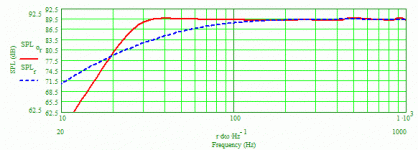Re: Re: Re: Just for kicks...
I agree on that !
I must say, I'm tempted to pursue the ML-TQWT-route you vouched
for, but I'll wait to hear how GM obtained his graph, going flat to 30Hz.
Thanks a lot, Paul, I really find your input very valuable !
The difference in viewpoints in a group of people can lead
to extraordinairy results, as long as everyone is open to
discussion (discussion as in argumented reasoning)
I wish I had more knowledge so I could give better input myself.
Feels like you are solving the puzzle for me.
But still, how can I ever learn if it wasn't for people like you ?
Don't worry about the sensitivty-issue,
I'll bi-amp the lot so matching can & will be done electronically.
The B139 spec's I listed are from the KEF datasheet as listed on
Dave's T-Line speakers site. I assume (and hope) they are correct,
not being able to measure my actual drivers....
pkitt said:
I will (and do) gladly give up response below 30 Hz in order to get a flat response to 40 Hz.
I agree on that !
I must say, I'm tempted to pursue the ML-TQWT-route you vouched
for, but I'll wait to hear how GM obtained his graph, going flat to 30Hz.
Thanks a lot, Paul, I really find your input very valuable !
The difference in viewpoints in a group of people can lead
to extraordinairy results, as long as everyone is open to
discussion (discussion as in argumented reasoning)
I wish I had more knowledge so I could give better input myself.
Feels like you are solving the puzzle for me.
But still, how can I ever learn if it wasn't for people like you ?
Don't worry about the sensitivty-issue,
I'll bi-amp the lot so matching can & will be done electronically.
The B139 spec's I listed are from the KEF datasheet as listed on
Dave's T-Line speakers site. I assume (and hope) they are correct,
not being able to measure my actual drivers....
Empee said:This would mean;
Volume Box = Vas (driver spec) / Resonant Freq. Box = Fs (driver spec) / Mass-Loaded TL ?
Ah !
it just dawned to me that Vb = Vas would mean:
Vbox = 349 Litres !
that's over three times the size of the box I was playing with in my drawings !!
sorry, no, too big.

I was just going to mention that. In the ML-TQWT I modeled, sensitivity issues notwithstanding, the gross volume in the line is ~64 liters. A TL is just like other box configurations; the larger the volume, the lower the bass response (which isn't always necessarily a good thing depending on several factors).
Empee said:
Ah !
it just dawned to me that Vb = Vas would mean:
Vbox = 349 Litres !
that's over three times the size of the box I was playing with in my drawings !!
sorry, no, too big.

Hi there !
The box I played with, gives a nett volume of ~115litres.
(that's the volume of the last line I drew, excluding the
planks to make up the line)
If I was to use all that volume, but with your idea of a ML-TQWT,
how would that end up ?
It's almost double the volume !
The box I played with, gives a nett volume of ~115litres.
(that's the volume of the last line I drew, excluding the
planks to make up the line)
If I was to use all that volume, but with your idea of a ML-TQWT,
how would that end up ?
It's almost double the volume !
Re: T/S values for the B139
Looks like they came from here:
http://p10hifi.net/planet10/TLS/drivers/images/B139B_newer.gif
I typically use this one (since i got it in my KEF book in the late 70s)
http://p10hifi.net/planet10/TLS/drivers/images/B139small.GIF (i should rescan that, it could look a lot better)
http://t-linespeakers.org/drivers/b139.html
Even thou i sold 100s of B139s in the late 70s, none of them have come back to me used (and i have looked) so that i can measure them myself.
dave
pkitt said:Empee listed all the specs for the B139
Looks like they came from here:
http://p10hifi.net/planet10/TLS/drivers/images/B139B_newer.gif
I typically use this one (since i got it in my KEF book in the late 70s)
http://p10hifi.net/planet10/TLS/drivers/images/B139small.GIF (i should rescan that, it could look a lot better)
http://t-linespeakers.org/drivers/b139.html
Even thou i sold 100s of B139s in the late 70s, none of them have come back to me used (and i have looked) so that i can measure them myself.
dave
planet10 said:I'm happier about this one...
Me too as it helps to attenuate unwanted HF output, reducing stuffing density requirements, not to mention stiffens the cab considerably.
GM
planet10 said:Thinking about this project, and where you plan to XO, you would probably be better off building 4 cabinets. Besides being able to optimally place the boxes, you would be relieved of the constraint of finding a place to put the FR8 in the B139 line.
dave
I'd be better off building the Coffin' Sub ?
If only I had the space....
Where to put the FR8 is indeed the hardest part of the puzzle,
it seems...
no-one said designing a good speaker was easy
planet10 said:
One spec sheet says 96 dB with 11V pink noise at 1m, the other 87 dB sensitivity...
Guys!
It was just a 'FWIW'! Maybe I should have explained that it's a 1 kHz, 2 pi calculation based on pistonic action that I use to compare relative efficiency and if I changed the SoS and air density specs to what MJK used, then my calc would match his worksheets. It's not meant to be the only 'correct' value. A measurement at a different frequency and/or a different ambient and/or with a broad spectrum signal such as pink noise will be different due to a variety of factors.
That said, I just mentioned it in passing and being rather preoccupied at the time didn't really give any thought as to why there was a 6 dB difference. Anyway, the data I have lists it as a nominally 8 ohm driver, so have always used a 7.2 ohms Re listed here for sims with no complaints/corrections.
GM
pkitt said:If I knew how to save it as a gif, I would!
What do you use to capture/save the sims?
Anyway, FWIW, I use a very old crippled trial version of SnagIt to capture/save stuff and it allows a wide variety of 'save as' extensions including GIF. I've noticed that IrfanView seems to be the most popular one though: http://www.oldapps.com/old_version_list_Image_Editing.php
GM
Empee said:
it just dawned to me that Vb = Vas would mean:
Vbox = 349 Litres !
Uh, the specs I have lists it as 127 L, so Vb = ~127 L net, though the driver's Sd is listed as 349 cm^2. As I noted though, a well damped TQWT needs to be around this size to play down to Fs with authority. Regardless, FWIW:
L = 61.67"
SO, SL = 125.68"2
zdriver = 22.3"
zport = 60"
dport = 3"
Lport = 3"
simmed stuffing density = 0.2 lbs/ft^3, i.e. ~what to expect if one side, top and back is covered with 1" thick acoustic fiberglass insulation.
Note that all dims are i.d. (inside) and approximate.
GM
GM said:
Uh, the specs I have lists it as 127 L, so Vb = ~127 L net, though the driver's Sd is listed as 349 cm^2.
I really should've gone to bed earlier yesterday

Empee said:I'd be better off building the Coffin' Sub ?
A pr of woofer only boxes would be more versatile.
dave
Empee said:
I really should've gone to bed earlier yesterday
Understood, I was 'dead' tired from yard work when I posted last night.......
Anyway, plugging the other specs Dave listed yields a somewhat selved response that takes several ohms of series resistance to flatten out, so again, BIB, i.e. better to use the larger cab's dims they dictate if you choose the MLTL since you can't measure yours:
L = 65.03"
SO, SL = 153.9"2
zdriver = 22.8"
zport = 63"
dport = 4"
Lport = 4"
Simmed stuffing density = 0.2 lbs/ft^3, i.e. ~what to expect if one side, top and back is covered with 1" thick acoustic fiberglass insulation and with 2.5 ohms series R for a direct comparison with my previous sim.
Note that all dims are i.d. (inside) and approximate.
GM
Attachments
Re: Re: Re: Just for kicks...
Well, it's all about in-room response and the best F3, F10/whatever depends on placement and room gain, so when it comes to making suggestions to folks I'll probably never meet or have a clue about their room's acoustics, I take the 'safe' choice of getting all the gain BW within reason and tuned as low as practical since it allows the greatest tuning flexibility. Others make arbitrary choices to shrink the cab/whatever that may not be valid for the app, which can lead to end user frustration and/or excessive shelving to flatten response over a wide BW if not forewarned.
WRT tuning, for a HIFI app I've found it best overall to tune a vented alignment at or below the lowest signal likely to be reproduced and if a stereo pair of speakers don't have enough dynamic headroom after any room effects are factored in, then either more must be added and/or a 'sub' system used to fill in to keep total distortion low. Even if there's lots of room gain, if tuned high, then all it's doing is amplifying a vented alignment's below Fb distortion if not tuned to be ~aperiodic, so all the more reason to tune it low otherwise.
Factor in the shape of our hearing acuity, using low tuned EBS or some form of ~aperiodic alignments are the best compromises since they have a phase response at least as good as a low Qtc sealed alignment higher up where we can hear the difference except with more gain BW, so all things considered, we'll have to agree to disagree.
GM
pkitt said:
As to F10 as so forth, my opinion is that having a shallower rolloff that results in a higher F3 but a better F10 is over-rated. There's so little information in "real" music below about 40 Hz and room gain, AFAIK, doesn't really come into play much above 40 Hz, that your assumption on hearing a big lump at the bottom is incorrect, but that's just my opinion. I will (and do) gladly give up response below 30 Hz in order to get a flat response to 40 Hz.
Well, it's all about in-room response and the best F3, F10/whatever depends on placement and room gain, so when it comes to making suggestions to folks I'll probably never meet or have a clue about their room's acoustics, I take the 'safe' choice of getting all the gain BW within reason and tuned as low as practical since it allows the greatest tuning flexibility. Others make arbitrary choices to shrink the cab/whatever that may not be valid for the app, which can lead to end user frustration and/or excessive shelving to flatten response over a wide BW if not forewarned.
WRT tuning, for a HIFI app I've found it best overall to tune a vented alignment at or below the lowest signal likely to be reproduced and if a stereo pair of speakers don't have enough dynamic headroom after any room effects are factored in, then either more must be added and/or a 'sub' system used to fill in to keep total distortion low. Even if there's lots of room gain, if tuned high, then all it's doing is amplifying a vented alignment's below Fb distortion if not tuned to be ~aperiodic, so all the more reason to tune it low otherwise.
Factor in the shape of our hearing acuity, using low tuned EBS or some form of ~aperiodic alignments are the best compromises since they have a phase response at least as good as a low Qtc sealed alignment higher up where we can hear the difference except with more gain BW, so all things considered, we'll have to agree to disagree.
GM
planet10 said:Thinking about this project, and where you plan to XO, you would probably be better off building 4 cabinets.
Agreed.
GM
Hey, Empee...
I modeled a larger ML-TQWT that has a line volume of ~98 liters. The closed end of the line is 12.5"W x 1"D, and the open end of the line is 12.5"W x 15"D. The mass-loading port has a diameter of 3", a length of 5" and its center is 3" from the open end of the line. As before, the driver's center is in the middle of the 60-inch-long line. I also modeled with an R(E) of 7.2 ohms, which makes the final sensitivity ~90 dB SPL. The (poor quality) attachment shows the system response and F3 is ~27 Hz, with a shallower roll-off below F3 compared to my previous model. I also used a lower stuffing density of 0.5 lb/cu.ft. for the same length of line as before. I will work on figuring out how to post better-quality graphs.
Empee said:Hi there !
The box I played with, gives a nett volume of ~115litres.
(that's the volume of the last line I drew, excluding the
planks to make up the line)
If I was to use all that volume, but with your idea of a ML-TQWT,
how would that end up ?
It's almost double the volume !
I modeled a larger ML-TQWT that has a line volume of ~98 liters. The closed end of the line is 12.5"W x 1"D, and the open end of the line is 12.5"W x 15"D. The mass-loading port has a diameter of 3", a length of 5" and its center is 3" from the open end of the line. As before, the driver's center is in the middle of the 60-inch-long line. I also modeled with an R(E) of 7.2 ohms, which makes the final sensitivity ~90 dB SPL. The (poor quality) attachment shows the system response and F3 is ~27 Hz, with a shallower roll-off below F3 compared to my previous model. I also used a lower stuffing density of 0.5 lb/cu.ft. for the same length of line as before. I will work on figuring out how to post better-quality graphs.
Attachments
Testing: How's this attachment look?
I downloaded some free software recommended by my son-in-law so I could post better quality graphs, etc. The attachment is an example just to see if I've been successful (don't pay any attention to the response as shown; it's just to see how good the graph appears here).
I downloaded some free software recommended by my son-in-law so I could post better quality graphs, etc. The attachment is an example just to see if I've been successful (don't pay any attention to the response as shown; it's just to see how good the graph appears here).
Attachments
Re: Testing: How's this attachment look?
Much better. The software should allow you to choose the number of colours/bits. You are using the maximum 256 colours/8 bits. With these charts 8 colours/3 bits is optimal
dave
pkitt said:I downloaded some free software recommended by my son-in-law so I could post better quality graphs, etc. The attachment is an example just to see if I've been successful (don't pay any attention to the response as shown; it's just to see how good the graph appears here).
Much better. The software should allow you to choose the number of colours/bits. You are using the maximum 256 colours/8 bits. With these charts 8 colours/3 bits is optimal
dave
- Status
- This old topic is closed. If you want to reopen this topic, contact a moderator using the "Report Post" button.
- Home
- Loudspeakers
- Multi-Way
- Made up a TL design... any comments ?



